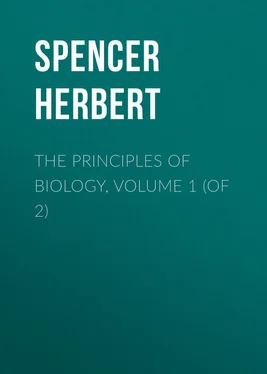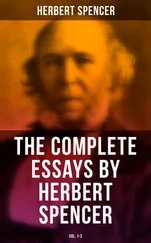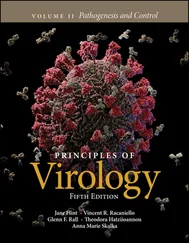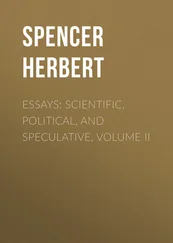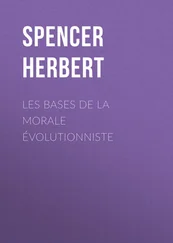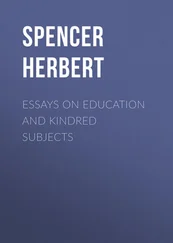Herbert Spencer - The Principles of Biology, Volume 1 (of 2)
Здесь есть возможность читать онлайн «Herbert Spencer - The Principles of Biology, Volume 1 (of 2)» — ознакомительный отрывок электронной книги совершенно бесплатно, а после прочтения отрывка купить полную версию. В некоторых случаях можно слушать аудио, скачать через торрент в формате fb2 и присутствует краткое содержание. Жанр: Философия, foreign_antique, foreign_prose, на английском языке. Описание произведения, (предисловие) а так же отзывы посетителей доступны на портале библиотеки ЛибКат.
- Название:The Principles of Biology, Volume 1 (of 2)
- Автор:
- Жанр:
- Год:неизвестен
- ISBN:нет данных
- Рейтинг книги:3 / 5. Голосов: 1
-
Избранное:Добавить в избранное
- Отзывы:
-
Ваша оценка:
- 60
- 1
- 2
- 3
- 4
- 5
The Principles of Biology, Volume 1 (of 2): краткое содержание, описание и аннотация
Предлагаем к чтению аннотацию, описание, краткое содержание или предисловие (зависит от того, что написал сам автор книги «The Principles of Biology, Volume 1 (of 2)»). Если вы не нашли необходимую информацию о книге — напишите в комментариях, мы постараемся отыскать её.
The Principles of Biology, Volume 1 (of 2) — читать онлайн ознакомительный отрывок
Ниже представлен текст книги, разбитый по страницам. Система сохранения места последней прочитанной страницы, позволяет с удобством читать онлайн бесплатно книгу «The Principles of Biology, Volume 1 (of 2)», без необходимости каждый раз заново искать на чём Вы остановились. Поставьте закладку, и сможете в любой момент перейти на страницу, на которой закончили чтение.
Интервал:
Закладка:
A kindred lesson meets us when from pathological evidence we turn to physiological evidence. The functions of some important organs may still be carried on for a time apart from those of the body as a whole. An excised liver, kept at a fit temperature and duly supplied with blood, secretes bile. Still more striking is the independent action of the heart. If belonging to a cold-blooded animal, as a frog, the heart, when detached, continues to beat, even until its integuments have become so dry that they crackle. Now though under such conditions its pulsations, which ordinarily form an essential part of the linked processes by which the correspondence between inner and outer actions is maintained, no longer form part of such processes, we must admit that the continuance of them implies a vital activity.
Embryological changes force the same truth upon us. What are we to say of the repeated cell-fissions by which in some types a blastula, or mulberry-mass, is formed, and in other types a blastoderm? Neither these processes nor the structures immediately resulting from them, show any correspondences with co-existences and sequences in the environment; though they are first steps towards the organization which is to carry on such correspondences. Even this extremely small fulfilment of the definition is absent in the cases of rudimentary organs, and especially those rudimentary organs which after being partly formed are absorbed. No adjustment can be alleged between the inner relations which these present and any outer relations. The outer relations they refer to ceased millions of years ago. Yet unquestionably the changes which bring about the production and absorption of these futile structures are vital changes.
Take another class of exceptions. What are we to say of a laugh? No correspondence, or part of a correspondence, by which inner actions are made to balance outer actions, can be seen in it. Or again, if, while working, an artisan whistles, the making of the sounds and the co-ordination of ideas controlling them, cannot be said to exhibit adjustment between certain relations of thoughts, and certain relations of things. Such kinds of vital activities lie wholly outside of the definition given.
But perhaps the clearest and simplest proof is yielded by contrasting voluntary and involuntary muscular actions. Here is a hawk adapting its changing motions to the changing motions of a pigeon, so as eventually to strike it: the adjustment of inner relations to outer relations is manifest. Here is a boy in an epileptic fit. Between his struggles and the co-existences and sequences around him there is no correspondence whatever. Yet his movements betray vitality just as much as do the movements of the hawk. Both exhibit that principle of activity which constitutes the essential element in our conception of life.
§ 36 b . Evidently, then, the preceding chapters recognize only the form of our conception of life and ignore the body of it. Partly sufficing as does the definition reached to express the one, it fails entirely to express the other. Life displays itself in ways which conform to the definition; but it also displays itself in many other ways. We are obliged to admit that the element which is common to the two groups of ways is the essential element. The essential element, then, is that special kind of energy seen alike in the usual classes of vital actions and in those unusual classes instanced above.
Otherwise presenting the contrast, we may say that due attention has been paid to the connexions among the manifestations, while no attention has been paid to that which is manifested. When it is said that life is "the definite correspondence of heterogeneous changes, both simultaneous and successive, in correspondence with external co-existences and sequences," there arises the question – Changes of what? Within the body there go on many changes, mechanical, chemical, thermal, no one of which is the kind of change in question; and if we combine in thought so far as we can these kinds of changes, in such wise that each maintains its character as mechanical, chemical, or thermal, we cannot get out of them the idea of Life. Still more clearly do we see this insufficiency when we take the more abstract definition – "the continuous adjustment of internal relations to external relations." Relations between what things? is the question then to be asked. A relation of which the terms are unspecified does not connote a thought but merely the blank form of a thought. Its value is comparable to that of a cheque on which no amount is written. If it be said that the terms cannot be specified because so many heterogeneous kinds of them have to be included, then there comes the reply that under cover of this inability to make a specification of terms that shall be adequately comprehensive, there is concealed the inability to conceive the required terms in any way.
Thus a critical testing of the definition brings us, in another way, to the conclusion reached above, that that which gives the substance to our idea of Life is a certain unspecified principle of activity. The dynamic element in life is its essential element.
§ 36 c . Under what form are we to conceive this dynamic element? Is this principle of activity inherent in organic matter, or is it something superadded? Of these alternative suppositions let us begin with the last.
As I have remarked, in another place, the worth of an hypothesis may be judged from its genealogy; and so judged the hypothesis of an independent vital principal does not commend itself. Its history carries us back to the ghost-theory of the savage. Suggested by experiences of dreams, there arises belief in a double – a second self which wanders away during sleep and has adventures but comes back on waking; which deserts the body during abnormal insensibility of one or other kind; and which is absent for a long period at death, though even then is expected eventually to return. This indwelling other-self, which can leave the body at will, is by-and-by regarded as able to enter the bodies of fellow men or of animals; or again, by implication, as liable to have its place usurped by the intruding doubles of fellow men, living or dead, which cause fits or other ills. Along with these developments its quality changes. At first thought of as quite material it is gradually de-materialized, and in advanced times comes to be regarded as spirit or breath; as we see in ancient religious books, where "giving up the ghost" is shown by the emergence of a small floating figure from the mouth of a dying man. This indwelling second self, more and more conceived as the real self which uses the body for its purposes, is, with the advance of intelligence, still further divested of its definite characters; and, coming in mediæval days to be spoken of as "animal spirits," ends in later days in being called a vital principle.
Entirely without assignable attributes, this something occurs in thought not as an idea but as a pseud-idea ( First Principles , Chap. II). It is assumed to be representable while really unrepresentable. We need only insist on answers to certain questions to see that it is simply a name for an alleged existence which has not been conceived and cannot be conceived.
1. Is there one kind of vital principle for all kinds of organisms, or is there a separate kind for each? To affirm the first alternative is to say that there is the same vital principle for a microbe as for a whale, for a tape-worm as for the person it inhabits, for a protococcus as for an oak; nay more – is to assert community of vital principle in the thinking man and the unthinking plant. Moreover, asserting unity of the vital principle for all organisms, is reducing it to a force having the same unindividualized character as one of the physical forces. If, on the other hand, different kinds of organisms have different kinds of vital principles, these must be in some way distinguished from one another. How distinguished? Manifestly by attributes. Do they differ in extension? Evidently; since otherwise that which animates the vast Sequoia can be no larger than that which animates a yeast-plant, and to carry on the life of an elephant requires a quantity of vital principle no greater than that required for a microscopic monad. Do they differ otherwise than in amount? Certainly; since otherwise we revert to the preceding alternative, which implies that the same quality of vital principle serves for all organisms, simple and complex: the vital principle is a uniform force like heat or electricity. Hence, then, we have to suppose that every species of animal and plant has a vital principle peculiar to itself – a principle adapted to use the particular set of structures in which it is contained. But dare anyone assert this multiplication of vital principles, duplicating not only all existing plants and animals but all past ones, and amounting in the aggregate to some millions?
Читать дальшеИнтервал:
Закладка:
Похожие книги на «The Principles of Biology, Volume 1 (of 2)»
Представляем Вашему вниманию похожие книги на «The Principles of Biology, Volume 1 (of 2)» списком для выбора. Мы отобрали схожую по названию и смыслу литературу в надежде предоставить читателям больше вариантов отыскать новые, интересные, ещё непрочитанные произведения.
Обсуждение, отзывы о книге «The Principles of Biology, Volume 1 (of 2)» и просто собственные мнения читателей. Оставьте ваши комментарии, напишите, что Вы думаете о произведении, его смысле или главных героях. Укажите что конкретно понравилось, а что нет, и почему Вы так считаете.
